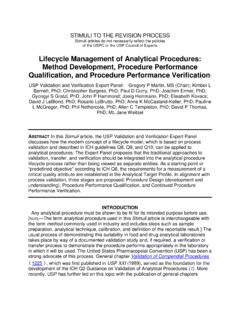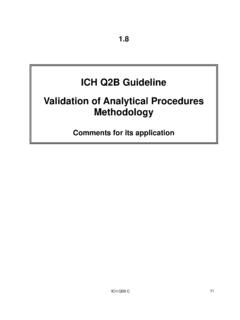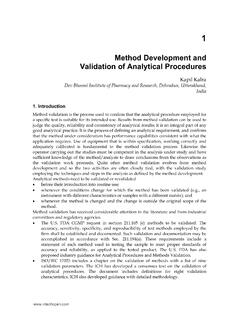Transcription of Chapter 9 - ANALYTICAL QUALITY ASSURANCE
1 Water QUALITY Monitoring - A Practical Guide to the Design and Implementation of Freshwater QUALITY Studies and Monitoring Programmes Edited by Jamie Bartram and Richard Ballance Published on behalf of United Nations Environment Programme and the World Health Organization 1996 UNEP/WHO ISBN 0 419 22320 7 (Hbk) 0 419 21730 4 (Pbk) Chapter 9 - ANALYTICAL QUALITY ASSURANCE This Chapter was prepared by R. Briggs This Chapter outlines the various techniques that may be employed in ANALYTICAL QUALITY ASSURANCE (AQA), and the reasons why they should be used. Reliability of data for a water QUALITY monitoring programme depends on strict adherence to a wide range of operating procedures for water sampling and analysis. It is the consistent application and monitoring of these procedures that is referred to as QUALITY ASSURANCE .
2 The subject can be confusing, especially if more than one reference work is used as an information source. Different authors may use different terms to describe the same thing or the same term to describe different things. A number of the terms used in ANALYTICAL QUALITY ASSURANCE are defined in Table The definitions are based on the vocabulary approved by the International Organization for Standardization (ISO) but may not have been universally adopted by those involved in AQA. In order to demonstrate that a laboratory is producing data of adequate precision, accuracy and sensitivity it is necessary to assess all laboratory procedures at all stages from sampling to reporting. This is a time consuming and costly process and, for this reason, it is important to ensure that the necessary standards of performance are clearly defined and adhered to.
3 In most laboratories, AQA will start with the examination and documentation of all aspects of laboratory management. This will include clearly identifying lines of communication and responsibility, the description and documentation of all procedures which are carried out, and the documentation of instrumental and ANALYTICAL checks. Within this there should be specific control and assessment procedures designed to monitor quantitatively the accuracy and precision of specific assays. ANALYTICAL QUALITY ASSURANCE procedures should be based on a system of traceability and feedback. Traceability, in this context, requires that all steps in a procedure can be checked, wherever possible, by reference to documented results, calibrations, standards, calculations, etc.
4 For example, where a balance is used in a laboratory, the accuracy of measurement must be regularly checked. The weights used for this purpose should either have a certificate demonstrating that they conform to a standard, or the balance must be regularly checked against such standards by the regular use of check weights which are well documented and thus can be linked within the laboratory to the calibration standard. This principle also applies to the calibration of other equipment. Feedback is the principle that problems or omissions in the AQA system should be brought to the attention of management. Where standards in the laboratory fall below acceptable limits, procedures should ensure that this is easily recognised and corrected.
5 Criteria for recognition and correction of poor performance, as well as responsibilities for corrective action, must be identified. The procedures for achieving this recognition and correction must be clearly established. Statistically based assay control systems, as used in internal and external QUALITY control programmes, should also conform to the principles of traceability and feedback to ensure that correct criteria for adequate QUALITY are adopted, and that any problems are quickly recognised and corrected. Table Definitions associated with ANALYTICAL QUALITY ASSURANCE Term Definition QUALITY The totality of characteristics of an entity that bear on its ability to satisfy stated and implied needs. QUALITY policy The overall intentions and direction of an organization with regard to QUALITY , as formally expressed by top management.
6 The QUALITY policy forms one element of corporate policy and is authorized by top management. QUALITY ASSURANCE All the planned and systematic activities implemented within the QUALITY system and demonstrated as needed, to provide adequate confidence that an entity will fulfil requirements for QUALITY . QUALITY system Organisational structure, procedures , processes, and resources needed to implement QUALITY management. Organisational structure The responsibilities, authorities and relationships through which an organization performs its functions. Procedure A specified way to perform an activity. When a procedure is documented, the terms Standard Operating Procedure written procedure or documented procedure & are frequently used.
7 A documented procedure usually contains the purposes and scope of an activity; what shall be done and by whom; when, where and how it shall be done; what materials, equipment and documents shall be used; and how it shall be controlled and recorded. Process A set of inter-related resources and activities that transform inputs into outputs. Resources may include personnel, finance, facilities, equipment, techniques and methods. QUALITY management All activities of the overall management function that determine the QUALITY policy, objectives and responsibilities, and implement them by means such as QUALITY planning, QUALITY control, QUALITY ASSURANCE , and QUALITY improvement within the QUALITY system. QUALITY control Operational techniques and activities that are used to fulfil requirements for QUALITY .
8 The terms Internal QUALITY control and external QUALITY control are commonly used. The former refers to activities conducted within a laboratory to monitor performance and the ]after refers to activities leading to comparison with other reference laboratories or consensus results amongst several laboratories. QUALITY audit Systematic and independent examination to determine whether QUALITY activities and related results comply with planned arrangements and whether these arrangements are implemented effectively and are suitable to achieve objectives. Traceability Ability to trace the history, application or location of an entity by means of recorded identifications. In the context of calibration, it relates measuring equipment to national or international standards, primary standards, basic physical constants or properties, or reference materials.
9 In the context of data collection, it relates calculation and data generated back to the QUALITY requirements for an entity Properly implemented AQA should demonstrate the standard to which a laboratory is working, ensure that this standard is monitored effectively and provide the means to correct any deviations from that standard. It is sometimes argued that the value of QUALITY ASSURANCE does not justify its cost but, without it, the reliability of data is doubtful and money spent on producing unreliable data is wasted. If 10 per cent of a laboratory s budget is spent on QUALITY ASSURANCE , the number of samples that can be analysed will be about 90 per cent of that possible if there were no QUALITY ASSURANCE programme.
10 However, the results obtained for that 90 per cent will be accurate, reliable and of consistent value to the monitoring programme. QUALITY ASSURANCE QUALITY ASSURANCE (QA) refers to the full range of practices employed to ensure that laboratory results are reliable. The term encompasses internal and external QUALITY control, but these specific aspects of AQA will be covered later. QUALITY ASSURANCE may be defined as the system of documenting and cross referencing the management procedures of the laboratory. Its objective is to have clear and concise records of all procedures which may have a bearing on the QUALITY of data, so that those procedures may be monitored with a view to ensuring that QUALITY is maintained. QUALITY ASSURANCE achieves these objectives by establishing protocols and QUALITY criteria for all aspects of laboratory work, and provides a framework within which internal QUALITY control (IQC) and external QUALITY control (EQC) programmes can be effective.
















